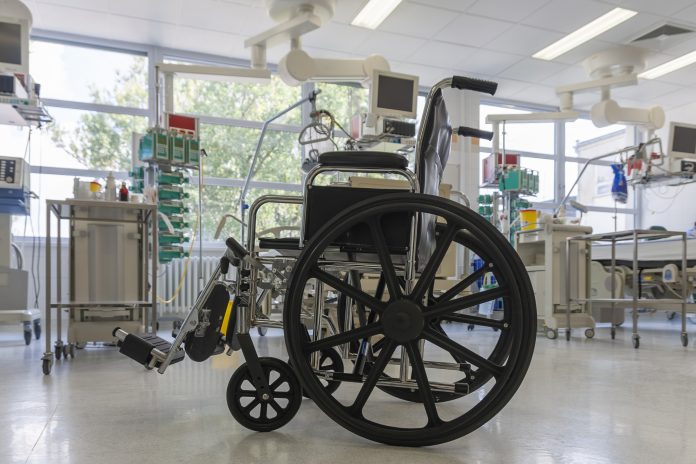Researchers have discovered that COVID-19 patients recover faster the sooner they undergo rehabilitation after leaving intensive care
COVID-19 patients can suffer long-term lung and heart damage, but this tends to improve over time, according to the first, prospective follow-up of infected coronavirus patients, presented at the European Respiratory Society International Congress.
Researchers from Austria recruited coronavirus patients to their study, who were hospitalised in various regions of Austria.
In their presentation to the virtual congress today (7 September), they reported on the first 86 patients enrolled between 29 April and 9 June, although now they have over 150 patients participating.
The patients were scheduled to return for evaluation six, 12 and 24 weeks after their discharge from hospital. During these visits, clinical examinations, laboratory tests, analysis of the amounts of oxygen and carbon dioxide in arterial blood, lung function tests, CT scans and echocardiograms were carried out.
At the time of their first visit, more than half of the patients had at least one persistent symptom, predominantly breathlessness and coughing, and CT scans still showed lung damage in 88% of patients.
However, by the time of their next visit 12 weeks after discharge, the symptoms had improved, and lung damage was reduced to 56%. At this stage, it is too early to have results from the evaluations at 24 weeks.
Sabina Sahanic, who was part of the team that carried out the study, said: “The bad news is that people show lung impairment from COVID-19 weeks after discharge; the good news is that the impairment tends to ameliorate over time, which suggests the lungs have a mechanism for repairing themselves.”
A link between COVID-19 and overweight patients and smokers?
The average age of the 86 patients was 61 and 65% of them were male. Nearly half of them were current or former smokers and 65% of hospitalised COVID-19 patients were overweight or obese.
21% had been in an intensive care unit (ICU), 19% had had invasive mechanical ventilation, and the average length of stay in hospital was 13 days.
65% of patients involved in the study showed persistent symptoms at the time of their six-week visit; breathlessness was the most common symptom (47% of patients), followed by coughing (15%). By the 12-week visit, breathlessness had improved to 39% of patients; however, 15% were still coughing.
Impact of COVID-19 on lung recovery
Tests of lung function included FEV1 (the amount of air that can be expelled forcibly in one second), FVC (the total volume of air expelled forcibly), and DLCO (a test to measure how well oxygen passes from the lungs into the blood).
These measurements also improved between the visits at six and 12 weeks. At six weeks, 23% of patients showed FEV1 as less than 80% of normal, improving to 21% at 12 weeks.
28% of patients showed FVC as less than 80% of normal, improving to 19% at 12 weeks. 33% of patients showed DLCO as less than 80% of normal, improving to 22% at 12 weeks.
The damage from inflammation and fluid in the lungs caused by the COVID-19, also improved; it was present in 88% of patients at six weeks and 56% at 12 weeks.
Sahanic, added: “The findings from this study show the importance of implementing structured follow-up care for patients with severe COVID-19 infection.
“Knowing how patients have been affected long-term by the coronavirus might enable symptoms and lung damage to be treated much earlier and might have a significant impact on further medical recommendations and advice.”
Pulmonary rehabilitation
In a second presentation to the Congress, Yara Al Chikhanie, a PhD student at the Grenoble Alps University, France, said that the sooner COVID-19 patients started a pulmonary rehabilitation programme after coming off ventilators, the better and faster their recovery.
Patients with severe COVID-19 can spend weeks in intensive care on ventilators. The lack of physical movement, on top of the severe infection, leads to severe muscle loss. The muscles for breathing are also affected, which weakens the breathing capacity.
Pulmonary rehabilitation, which involves physical exercises and advice on managing symptoms, is crucial for helping COVID-19 patients to recover fully.
Yara Al Chikhanie used a walking test to evaluate the weekly progress of 19 patients who had spent an average of three weeks in intensive care.
The walking test measured how far the patients could walk in six minutes. At the beginning, they were able to walk an average of 16% of the distance that, in theory, they should be able to walk normally if healthy. After three weeks of pulmonary rehabilitation, this increased to an average of 43%, which was a significant gain but still a serious impairment.
Al Chikhanie said: “The most important finding was that patients who were admitted to pulmonary rehabilitation shortly after leaving intensive care, progressed faster than those who spent a longer period in the pulmonary ward where they remained inactive.
“The sooner rehabilitation started and the longer it lasted, the faster and better was the improvement in patients’ walking and breathing capacities and muscle gain.”











